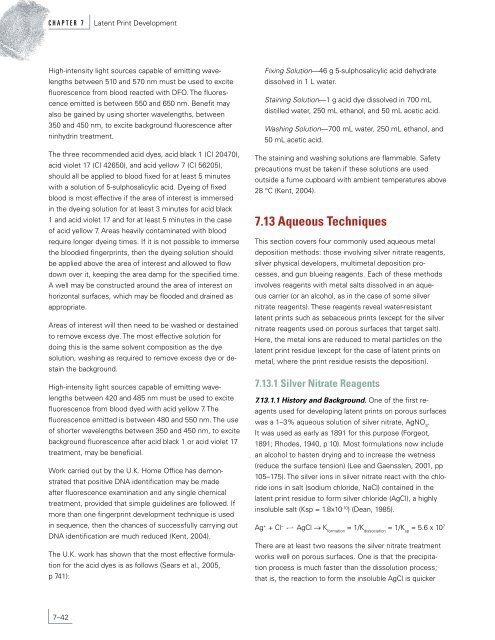Latent Print Development - National Criminal Justice Reference ...
Latent Print Development - National Criminal Justice Reference ...
Latent Print Development - National Criminal Justice Reference ...
Create successful ePaper yourself
Turn your PDF publications into a flip-book with our unique Google optimized e-Paper software.
C H A P T E R 7 <strong>Latent</strong> <strong>Print</strong> <strong>Development</strong><br />
High-intensity light sources capable of emitting wavelengths<br />
between 510 and 570 nm must be used to excite<br />
fluorescence from blood reacted with DFO. The fluorescence<br />
emitted is between 550 and 650 nm. Benefit may<br />
also be gained by using shorter wavelengths, between<br />
350 and 450 nm, to excite background fluorescence after<br />
ninhydrin treatment.<br />
The three recommended acid dyes, acid black 1 (CI 20470),<br />
acid violet 17 (CI 42650), and acid yellow 7 (CI 56205),<br />
should all be applied to blood fixed for at least 5 minutes<br />
with a solution of 5-sulphosalicylic acid. Dyeing of fixed<br />
blood is most effective if the area of interest is immersed<br />
in the dyeing solution for at least 3 minutes for acid black<br />
1 and acid violet 17 and for at least 5 minutes in the case<br />
of acid yellow 7. Areas heavily contaminated with blood<br />
require longer dyeing times. If it is not possible to immerse<br />
the bloodied fingerprints, then the dyeing solution should<br />
be applied above the area of interest and allowed to flow<br />
down over it, keeping the area damp for the specified time.<br />
A well may be constructed around the area of interest on<br />
horizontal surfaces, which may be flooded and drained as<br />
appropriate.<br />
Areas of interest will then need to be washed or destained<br />
to remove excess dye. The most effective solution for<br />
doing this is the same solvent composition as the dye<br />
solution, washing as required to remove excess dye or destain<br />
the background.<br />
High-intensity light sources capable of emitting wavelengths<br />
between 420 and 485 nm must be used to excite<br />
fluorescence from blood dyed with acid yellow 7. The<br />
fluorescence emitted is between 480 and 550 nm. The use<br />
of shorter wavelengths between 350 and 450 nm, to excite<br />
background fluorescence after acid black 1 or acid violet 17<br />
treatment, may be beneficial.<br />
Work carried out by the U.K. Home Office has demonstrated<br />
that positive DNA identification may be made<br />
after fluorescence examination and any single chemical<br />
treatment, provided that simple guidelines are followed. If<br />
more than one fingerprint development technique is used<br />
in sequence, then the chances of successfully carrying out<br />
DNA identification are much reduced (Kent, 2004).<br />
The U.K. work has shown that the most effective formulation<br />
for the acid dyes is as follows (Sears et al., 2005,<br />
p 741):<br />
7–42<br />
Fixing Solution—46 g 5-sulphosalicylic acid dehydrate<br />
dissolved in 1 L water.<br />
Staining Solution—1 g acid dye dissolved in 700 mL<br />
distilled water, 250 mL ethanol, and 50 mL acetic acid.<br />
Washing Solution—700 mL water, 250 mL ethanol, and<br />
50 mL acetic acid.<br />
The staining and washing solutions are flammable. Safety<br />
precautions must be taken if these solutions are used<br />
outside a fume cupboard with ambient temperatures above<br />
28 °C (Kent, 2004).<br />
7.13 Aqueous Techniques<br />
This section covers four commonly used aqueous metal<br />
deposition methods: those involving silver nitrate reagents,<br />
silver physical developers, multimetal deposition processes,<br />
and gun blueing reagents. Each of these methods<br />
involves reagents with metal salts dissolved in an aqueous<br />
carrier (or an alcohol, as in the case of some silver<br />
nitrate reagents). These reagents reveal water-resistant<br />
latent prints such as sebaceous prints (except for the silver<br />
nitrate reagents used on porous surfaces that target salt).<br />
Here, the metal ions are reduced to metal particles on the<br />
latent print residue (except for the case of latent prints on<br />
metal, where the print residue resists the deposition).<br />
7.13.1 Silver Nitrate Reagents<br />
7.13.1.1 History and Background. One of the first reagents<br />
used for developing latent prints on porous surfaces<br />
was a 1–3% aqueous solution of silver nitrate, AgNO . 3<br />
It was used as early as 1891 for this purpose (Forgeot,<br />
1891; Rhodes, 1940, p 10). Most formulations now include<br />
an alcohol to hasten drying and to increase the wetness<br />
(reduce the surface tension) (Lee and Gaensslen, 2001, pp<br />
105–175). The silver ions in silver nitrate react with the chloride<br />
ions in salt (sodium chloride, NaCl) contained in the<br />
latent print residue to form silver chloride (AgCl), a highly<br />
insoluble salt (Ksp = 1.8x10-10 ) (Dean, 1985).<br />
Ag + + Cl – AgCl → K formation = 1/K dissociation = 1/K sp = 5.6 x 10 7<br />
There are at least two reasons the silver nitrate treatment<br />
works well on porous surfaces. One is that the precipitation<br />
process is much faster than the dissolution process;<br />
that is, the reaction to form the insoluble AgCl is quicker

















